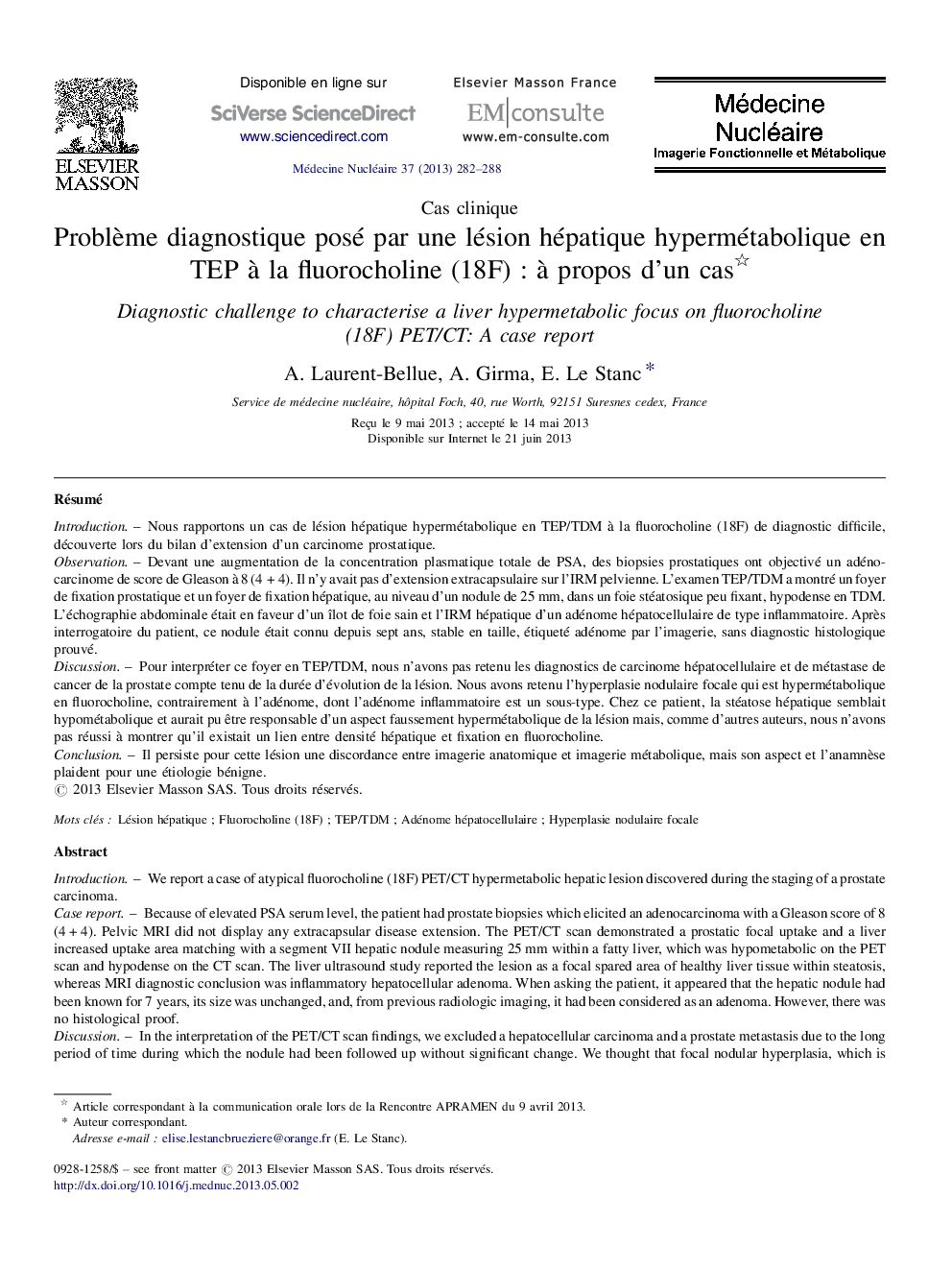| کد مقاله | کد نشریه | سال انتشار | مقاله انگلیسی | نسخه تمام متن |
|---|---|---|---|---|
| 4243924 | 1283361 | 2013 | 7 صفحه PDF | دانلود رایگان |

RésuméIntroductionNous rapportons un cas de lésion hépatique hypermétabolique en TEP/TDM à la fluorocholine (18F) de diagnostic difficile, découverte lors du bilan d’extension d’un carcinome prostatique.ObservationDevant une augmentation de la concentration plasmatique totale de PSA, des biopsies prostatiques ont objectivé un adénocarcinome de score de Gleason à 8 (4 + 4). Il n’y avait pas d’extension extracapsulaire sur l’IRM pelvienne. L’examen TEP/TDM a montré un foyer de fixation prostatique et un foyer de fixation hépatique, au niveau d’un nodule de 25 mm, dans un foie stéatosique peu fixant, hypodense en TDM. L’échographie abdominale était en faveur d’un îlot de foie sain et l’IRM hépatique d’un adénome hépatocellulaire de type inflammatoire. Après interrogatoire du patient, ce nodule était connu depuis sept ans, stable en taille, étiqueté adénome par l’imagerie, sans diagnostic histologique prouvé.DiscussionPour interpréter ce foyer en TEP/TDM, nous n’avons pas retenu les diagnostics de carcinome hépatocellulaire et de métastase de cancer de la prostate compte tenu de la durée d’évolution de la lésion. Nous avons retenu l’hyperplasie nodulaire focale qui est hypermétabolique en fluorocholine, contrairement à l’adénome, dont l’adénome inflammatoire est un sous-type. Chez ce patient, la stéatose hépatique semblait hypométabolique et aurait pu être responsable d’un aspect faussement hypermétabolique de la lésion mais, comme d’autres auteurs, nous n’avons pas réussi à montrer qu’il existait un lien entre densité hépatique et fixation en fluorocholine.ConclusionIl persiste pour cette lésion une discordance entre imagerie anatomique et imagerie métabolique, mais son aspect et l’anamnèse plaident pour une étiologie bénigne.
IntroductionWe report a case of atypical fluorocholine (18F) PET/CT hypermetabolic hepatic lesion discovered during the staging of a prostate carcinoma.Case reportBecause of elevated PSA serum level, the patient had prostate biopsies which elicited an adenocarcinoma with a Gleason score of 8 (4 + 4). Pelvic MRI did not display any extracapsular disease extension. The PET/CT scan demonstrated a prostatic focal uptake and a liver increased uptake area matching with a segment VII hepatic nodule measuring 25 mm within a fatty liver, which was hypometabolic on the PET scan and hypodense on the CT scan. The liver ultrasound study reported the lesion as a focal spared area of healthy liver tissue within steatosis, whereas MRI diagnostic conclusion was inflammatory hepatocellular adenoma. When asking the patient, it appeared that the hepatic nodule had been known for 7 years, its size was unchanged, and, from previous radiologic imaging, it had been considered as an adenoma. However, there was no histological proof.DiscussionIn the interpretation of the PET/CT scan findings, we excluded a hepatocellular carcinoma and a prostate metastasis due to the long period of time during which the nodule had been followed up without significant change. We thought that focal nodular hyperplasia, which is fluorocholine avid, was the most likely diagnosis, knowing that hepatocellular adenomas, including the inflammatory type, have not been reported to display increased fluorocholine uptake. We noticed that the patient's fatty liver uptake was low, which could have accounted for a falsely increased uptake by the nodule. But, similarly to other authors, we could not find any relationship between CT density and fluorocholine uptake.ConclusionThis case shows a discrepancy between the radiologic and nuclear medicine findings. However, this hepatic nodule is likely to be benign because of the lesion characteristics and the patient medical history.
Journal: Médecine Nucléaire - Volume 37, Issue 7, July 2013, Pages 282–288